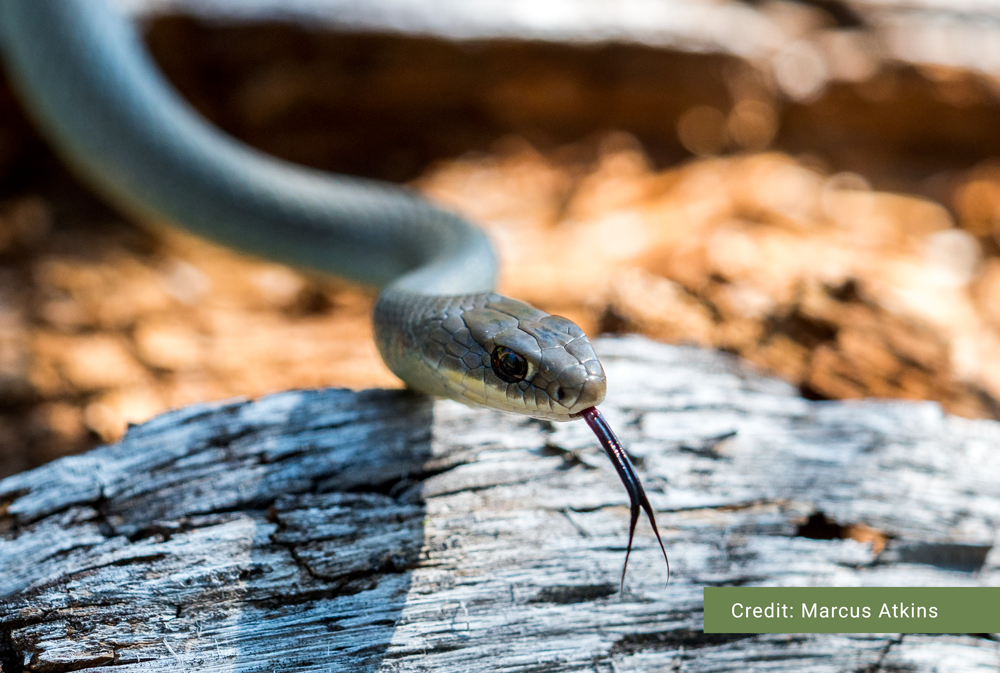Snake Locomotion
Lateral Undulation
Lateral undulation (or undulatory locomotion) is the type of movement that most people associate with snakes. The snake uses a serpentine motion to create a wave-like movement that propels it forward. Lampreys and eels use a similar motion underwater to move around. This wave-like motion creates a series of bends along the body of the snake and whenever one of these bends comes into contact with a surface or object it exerts force against it and propels the animal forward. Snakes are capable of creating this wave-like motion by activating the large dorsal muscles on each side of the body sequentially. The lateral (sideways) forces brace the body (because the motion in each lateral direction cancel each other out) against the ground leaving only forward forces to propel the snake. Because of this, sliding friction is critical to lateral undulation. This sort of movement requires a high level of sensory motor control, as the snake must make micro-adjustments along its body at each curve to keep in contact with the surface it is moving on.
Sidewinding
Sidewinding is used by snakes that crawl along smooth or slipper surfaces. The best-known species that uses this type of movement is the Sidewinder Rattlesnake (Crotalus cerastes) and a few desert viper species in Africa and Asia. Sidewinding is similar to lateral undulation in the pattern of bending, but differs in 3 major ways: 1) Each point along the body is sequentially placed in static (as opposed to sliding) friction with the ground. 2) The segments, or bends, are lifted off the ground between regions of static contact with the ground. This creates a characteristic track in sand. As the body is lifted off the ground and set down a short distance away, the front part of the body begins a new track while the rear part of the body completes the old track. 3) Since there is static contact and lifting of the body, the snake travels approximately diagonally relative to the tracks it forms on the ground. The muscles active in sidewinding are similar to lateral undulation except some muscles are also active bilaterally to assist in lifting the body. In extremely hot environments, this type of movement also helps snakes to not overheat as they move across scorching sands.
Be sure to also check out this amazing video of sidewinding and camouflage by the Peringuey’s Adder.
Concertina
Concertina locomotion moves the snake by alternately pulling up the body into bends and then straightening out the body forward from the bends. The front part of the body then comes to rest on the surface and the back part of the body is pulled up into bends again. Rinse and repeat and you’re moving. This type of movement is definitely not the speediest way to get around, but it is often used by snakes that are trying to squeeze into a tunnel, burrow, or crevice where there isn’t enough space to use lateral undulation effectively. The bends in the body may push laterally against the sides of a tunnel or burrow, or vertically against the ground, to keep the body from slipping, therefore, static friction is essential to concertina locomotion.
Rectilinear Locomotion
Rectilinear locomotion is movement in a straight line, and is mainly used by large species such as vipers, boas, and pythons. Rectilinear locomotion is different from the other types of snake movement in that it involves lifting the belly scales slightly from the ground, pulling them forward, and then pulls them down and backward to propel the snake forward. The motion of pulling the scales down and backward actually moves the snake forward and the edges of the scales dig into the ground. Once the body has moved far enough forward to stretch the scales, the process repeats. This process happens simultaneously at several point along the body. Unlike lateral undulation and sidewinding that unilaterally uses muscles on each side of the body sequentially, rectilinear locomotion uses the muscles that connect the skin to the skeleton. One set of muscles lifts the belly scale sup and pulls them forwards, and another set of muscles pulls them down and backwards.

